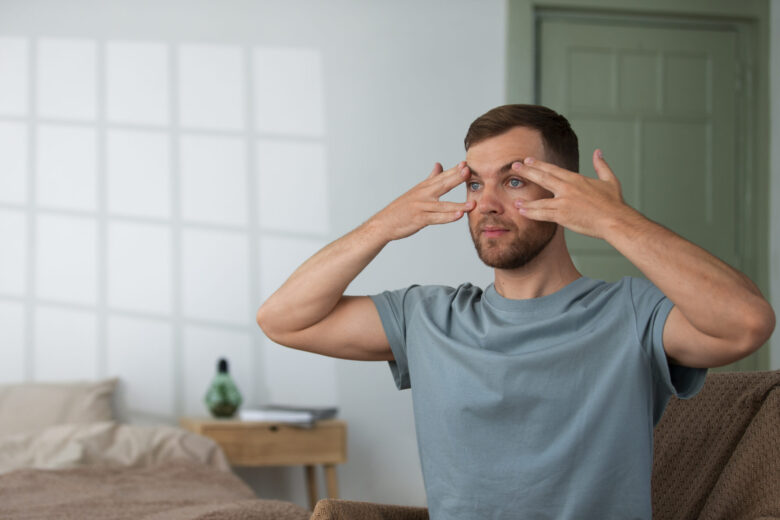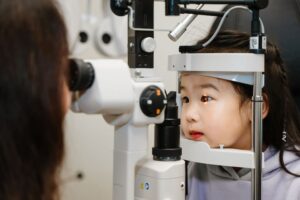In today’s digitally oriented world, screens are a constant companion, whether we’re checking emails, browsing social media, attending online meetings, or watching TV shows. While all that connectivity is fantastic, it also has its drawbacks: digital eye strain, also known as computer vision disease (PCD). Millions of people worldwide suffer from this condition, which can cause dry eyes, blurred vision, headaches, and even neck and shoulder pain.
The good news is that these problems can be alleviated without expensive treatments or gadgets. Quick and easy eye exercises can help relieve pain and maintain your long-term eye health. This article introduces some simple exercises and practical tips to keep your eyes healthy and alert all day long.
What is screen strain?
Digital eye strain refers to a range of vision problems that occur with prolonged use of digital devices such as computers, tablets, and smartphones. The American Optometric Association (AOA) states that more than half of all computer users experience some form of digital eye strain. People of all ages can develop this condition. Children and teenagers who use electronic devices for gaming or virtual learning are also at risk.
Common symptoms include eye strain, difficulty focusing, blurred or double vision, and dry or watery eyes. Some people also experience persistent headaches and pain around the eyes. Digital eye strain usually doesn’t cause permanent damage, but left untreated, it can significantly reduce your comfort and efficiency in daily life.
How Eye Exercises Can Help?
The eyes have small muscles that are constantly shifting focus, moving, and focusing. They can become tired from overuse, just like other muscles in the body. Eye exercises can help relax these muscles. They make it easier to focus, naturally release water from your eyes, and relieve the strain of prolonged screen time. You can easily and effectively combat the effects of digital stress by incorporating these exercises into your daily routine.
Five Simple Eye Exercises to Relieve Eye Strain from Screen Time
- The 20-20-20 rule is a well-known way to prevent eye strain: Every 20 minutes, stare at an object 20 feet away for 20 seconds. This helps your eyes recalibrate and shift their focus away from nearby screens. This prevents eye strain from prolonged close-up staring.
- Another good technique is eye rotation: Slowly roll your eyeballs, first clockwise and then counterclockwise. This promotes blood flow to your eyes and relaxes the tense muscles around them.
- Shifting your focus helps your eyes adjust to seeing objects near and far: Hold your thumb about 10 inches from your face and stare at it for 15 seconds. After 15 seconds, shift your attention to an object at least 10 to 20 feet away. Repeating this cycle helps your eyes focus better.
- Palm massage is a relaxing method: rub your hands together to warm them and place them gently over your closed eyes. This simple technique calms the optic nerves and temporarily relaxes the eyes, which is very helpful for people who spend long hours in front of a screen.
- Blinking consciously is another important habit: When people look at a screen, they blink less, which can lead to dry, sore eyes. Try blinking every four seconds for a few minutes, several times a day. This keeps the tear film healthy and hydrates the eyes.
Screen Time and the Risk of Eye Strain
The chart below shows the prevalence of digital eye strain among different age groups and the amount of time they spend in front of a screen each day.
| Age Group | Avg. Daily Screen Time | Reported Eye Strain (%) |
|---|---|---|
| Teens (13–18) | 7+ hours | 65% |
| Adults (19–35) | 9+ hours | 75% |
| Adults (36–60) | 7–8 hours | 68% |
| Seniors (60+) | 5–6 hours | 50% |
Source: National Institutes of Health (NIH), American Optometric Association (AOA)
This data illustrates that higher screen time is consistently associated with a greater risk of developing eye strain symptoms. Being proactive about eye care is essential regardless of age.
Tips for combining eye exercises
Exercise is beneficial, but it’s best combined with good screen habits. You can reduce glare and eye strain by adjusting the screen brightness and color to your surrounding lighting. You can also use blue light filters to better protect your eyes, for example, through computer settings or special glasses. This is especially important in dimly lit rooms or at night.
Standing is also important. Keep the screen 50 to 60 cm from your face and at eye level. This prevents neck and shoulder strain and reduces eye strain. If you have persistent dry eyes, artificial tears can help, but consult an ophthalmologist before using them regularly.
FAQ
How often should I exercise my eyes?
Do a short exercise every 20 minutes, such as the 20-20-20 rule, when sitting in front of a screen. Other exercises, such as palm massage or eye rotation, are most effective when performed one to three times a day.
Can eye exercises help you see better? Some eye exercises can help you maintain comfort, balance, and focus, but they don’t address vision problems like nearsightedness or farsightedness. They can, however, help reduce eye strain and maintain overall eye health.
Is there a link between blue light and digital eye strain?
Yes, the blue light from digital screens can strain your eyes and disrupt your normal sleep cycle. You can reduce these effects by using a blue light filter or switching to night mode.
Do I need anything special to exercise my eyes?
No special equipment is required. Most exercises are easy to do at home or at work because you only need your hands or nearby objects.
When should I have my eyes checked?
If you have chronic symptoms such as headaches, blurred vision, or difficulty concentrating that don’t improve with rest and exercise, consult a qualified optometrist for a comprehensive eye exam.
In short, electronics are here to stay, but that doesn’t mean your eyes have to suffer. Adding simple eye exercises to your daily routine can significantly reduce digital eye strain and improve your quality of life. Combining these exercises with good screen settings and varying lighting can effectively prevent strain or discomfort.
Do one or two exercises today, such as palm massage or the 20-20-20 rule, and gradually improve. By protecting your eyes now, you’ll feel better, focus better, and get more done in the future.
Resources
- The American Academy of Ophthalmology (AAP) offers information about computer vision syndrome.
- National Eye Institute (NEI): How to Protect Your Eyes
- Centers for Disease Control and Prevention (CDC) Vision Health Initiative




